When Mom Gets LOST
What happens when the mother is immersed in a big long combox discussion of her favorite TV show?
Crackers happen, that’s what.
What happens when the mother is immersed in a big long combox discussion of her favorite TV show?
Crackers happen, that’s what.
Here be spoilers, of course. Don’t read this if you haven’t watched the LOST finale.
Earlier this week, Phoebe asked me to recommend books about the middle ages. Jane and I went around the house pulling things off shelves. The timing was perfect, because I’ve been on a bit of a middle ages jag myself, ever since reading The Perilous Gard (so good! read it!!) which though set in Tudor times, at the cusp of Elizabeth’s reign, is a retelling of the medieval Tam Lin ballad. I’ve listened to perhaps a dozen different renditions of Tam Lin over the past few weeks; this one by Bob Hay and the Jolly Beggars.
Here’s a list of the middle-ages-related books we found around the house. There are many other wonderful books about the middle ages, of course. (Rosemary Sutcliffe and Susan Cooper novels come to mind.) Feel free to leave your own lists (or links to your lists) in the comments!
Disclaimer: Not all of these are appropriate for younger children.
** indicates my family’s favorites
HISTORICAL FICTION AND FANTASY
• Medieval Romances edited by Roger Sherman Loomis & Laura Hibbard Loomis (Perceval, Tristan & Isolt, Sir Gawain & the Green Knight, etc; this was the text for my college Medieval Lit class & has a highly quotable intro, which I shall indeed quote in the next post)
• Favorite Medieval Tales by Mary Pope Osborne, illustrated by Troy Howell (Finn Maccoul, Beowulf, Arthur, Song of Roland, Sir Gawain & the Green Knight; Robin Hood, Chanticleer)**
• The Story of King Arthur and His Knights by Howard Pyle
• The Sword in the Stone by T.H. White (Arthur)**
• The Acts of King Arthur and His Noble Knights by John Steinbeck (based on the Malory)
• The Story of King Arthur by Tom Crawford (Dover Children’s Classics)
• The Canterbury Tales by Chaucer (of course!!)
NONFICTION
• The Story of the World, Vol. 2: The Middle Ages by Susan Wise Bauer
• How the Irish Saved Civilization by Thomas Cahill
• Living Long Ago (Usborne Books, lots of pictures: clothes, customs, housing)
• Famous Men of the Middle Ages by John H. Haaren & A. B. Poland (Attila the Hun, Barbarossa, Clovis, Justinian, etc)**
• A Medieval Feast by Aliki (picture book)**
• The Life of King Alfred by Asser, Bishop of Sherborne (written in Latin around 888AD, translated by J.A. Giles)
NONFICTION, SORT OF (contains legend or considerable fictionalization)
• Our Island Story by H.E. Marshall
• The Sailor Who Captured the Sea by Deborah Nourse Lattimore (picture book: Book of Kells; illuminated manuscripts; monasteries; Vikings attack Ireland) (This maybe belongs just under fiction)
SAINT STORIES
Around the Year: Once Upon a Time Saints by Ethel Pochocki (not all the saints depicted here are medieval, but many are)
Our Island Saints by Amy Steedman
Patrick, Saint of Ireland by Tomie de Paola (picture book; early middle ages)
Tomie de Paola also did picture books about St Francis and Sts Benedict & Scholastica, but I couldn’t find those today)
Brigid’s Cloak by Bryce Milligan, illustrated by Helen Cann
FOLK AND FAIRY TALES WITH A MEDIEVAL FLAVOR
• Saint George and the Dragon by Margaret Hodges, illustrated by Trina Schart Hyman (picture book; although St George predates the middle ages, the dragon legend comes from Spenser’s The Faerie Queen [1590] and is based on medieval writings–the Arthurian stories of Geoffrey of Monmouth [1136]; Hyman’s illustrations have borders reminiscent of illuminated manuscripts)
• Chanticleer and the Fox by Barbara Cooney, based on the story from The Canterbury Tales**
• Heckedy Peg by Don & Audrey Wood (picture book; fairy tale; setting is a medieval village)**
• The Irish Cinder Lad by Shirley Climo, illustrated by Loretta Krupinski (picture book; Irish fairy tale; dragon, castle, princess)
• The Three Sorrowful Tales of Erin by F.M. Pilkington (Irish fairy tales; Children of Lir)
• The King of Ireland’s Son by Padraic Colum (novel-length Irish folk tale)**
OTHER WORKS OF NOTE:
Twain’s bio of St. Joan of Arc
Heaney’s translation of Beowulf
Dante’s Divine Comedy
Stories about Robin Hood (we have several versions
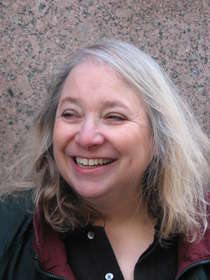 I am pretty excited about today’s post. When I got my first job in children’s publishing, working as the editorial assistant to Stephanie Spinner at Random House, one of the best parts of the job was getting to meet and talk to and learn from Real Writers. And by far my favorite of the many wonderful writers I met in that context was an author named Ellen Weiss, who had a staggering number of books to her credit. Her writing was hilarious—I think The Poof Point was the first one of Ellen’s books I read on the job, and I remember Stephanie poking her head out of her office to see what kept making me giggle out loud—and Ellen herself was one of the kindest, warmest people I had ever (and still have ever) met.
I am pretty excited about today’s post. When I got my first job in children’s publishing, working as the editorial assistant to Stephanie Spinner at Random House, one of the best parts of the job was getting to meet and talk to and learn from Real Writers. And by far my favorite of the many wonderful writers I met in that context was an author named Ellen Weiss, who had a staggering number of books to her credit. Her writing was hilarious—I think The Poof Point was the first one of Ellen’s books I read on the job, and I remember Stephanie poking her head out of her office to see what kept making me giggle out loud—and Ellen herself was one of the kindest, warmest people I had ever (and still have ever) met.
And one of the funniest. When Ellen’s latest picture book, The Taming of Lola: A Shrew Story, arrived here, Rilla promptly claimed it as her own. This time it was Scott who poked his head into the room to see what was making us giggle so hard.
“Ellen’s new book,” I told him.
“Aha,” he said. “That explains it.”
Exactly.
I asked Ellen if she would be so kind as to let me interview her here on Bonny Glen. I wanted to grill her about Lola, her awesomely titled new beginning reader, Porky and Bess, and her amazing career as the author of more than 150 books for children.
So Ellen, can you talk about how you got started?
Ellen Weiss: You know how when you’re young, you totally don’t appreciate what you have? Well, that was the story with my first real job. It was the most incredible job of my life, and I didn’t have a clue that I’d never have another one that was so much fun.
A looong time ago, I was working behind the desk at the East Asian Library at Columbia U., which was just as much career as I’d ever contemplated. There was a tiny ad in the Columbia Spectator for something like silly people who liked kids. Didn’t say what the job was. So I applied, and I got it, and it turned out to be a new kids’ magazine called Dynamite. There had never been anything like it. Before that, the world of kids’ magazines had tended toward two-color fun like Goofus and Gallant. Dynamite was full color and bursting with hipness and fun.
I must interject: How well I remember! I LOVED Dynamite. That and another magazine I remember as “WOW (is Mom upside down)”—I think I had subscriptions to both of them at one point.
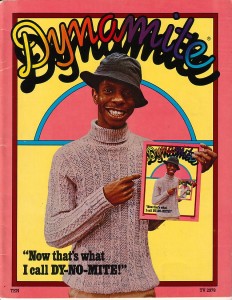 Ellen: Dynamite was published by Scholastic, and was the brain-child of Jenette Kahn, who, in addition to being a knockout, had an electric intelligence and a knack for attracting interesting people. I was very lucky to be a part of this group, some of whom are still my closest friends. We worked long hours, wasted huge amounts of time laughing our heads off, and put out a magazine that was such a huge success that we had a circulation of about a million and a half almost immediately. It was gigantic fun.
Ellen: Dynamite was published by Scholastic, and was the brain-child of Jenette Kahn, who, in addition to being a knockout, had an electric intelligence and a knack for attracting interesting people. I was very lucky to be a part of this group, some of whom are still my closest friends. We worked long hours, wasted huge amounts of time laughing our heads off, and put out a magazine that was such a huge success that we had a circulation of about a million and a half almost immediately. It was gigantic fun.
We only did three issues of Dynamite, and then left as a group to start another magazine, Smash, which didn’t do quite as well but was just as much fun to put together. Just four of us in a brownstone apartment, which was always referred to in the magazine as the Smash Building. It was art-directed by the great Milton Glaser, so each issue was a work of art. Its motto was “The Magazine With Three Free Staples.”
It took a few years for Smash to end its run, after which I went to what was then called Children’s Television Workshop to edit The Electric Company Magazine, a spinoff of the TV show. Much more corporate and sober. Not not-fun, but many more rules. By the time I had my daughter, in 1979, I was ready to go freelance. It was a natural progression to start writing Muppet books, which I loved doing. Over many years I wrote several score of them. The best group of characters ever created, IMHO.
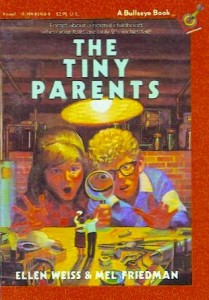 Eventually, though, I wanted to create characters of my own. First I had to convince my great Random House editor and good friend Stephanie Spinner that I could do it. Thankfully, I was able to do that, which resulted in our first “all ours” book, The Tiny Parents. Since then, I’ve managed to maintain a balance between the “ours” (or “mine”) books and assigned work, which fills in the gaps to pay the rent—always trying to tip the scales farther toward the former works. My guess is that all told, I’ve written about 150-200 books.
Eventually, though, I wanted to create characters of my own. First I had to convince my great Random House editor and good friend Stephanie Spinner that I could do it. Thankfully, I was able to do that, which resulted in our first “all ours” book, The Tiny Parents. Since then, I’ve managed to maintain a balance between the “ours” (or “mine”) books and assigned work, which fills in the gaps to pay the rent—always trying to tip the scales farther toward the former works. My guess is that all told, I’ve written about 150-200 books.
200 books. You fill me with awe. It’s amazing to think how much of your writing I read long before I met you—not just Dynamite but your Muppets stuff as well, I’m sure. During college I had a regular babysitting gig for kids who were Muppet fanatics. Those books were actually fun to read—not like certain big thick animated-movie-tie-in storybooks, NOT written by Ellen Weiss, which used to be agony to get through.
Okay, on to your new books…
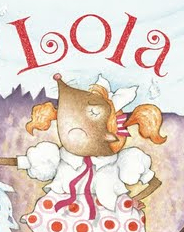 The Taming of Lola, brilliantly illustrated by Jerry Smath, is about a disagreeable young shrew who is accustomed to getting her way, one way or the other. If imperiousness won’t work, a royal tizzy will. Her volcanic-level tantrums keep her family nicely under her sway—until young Cousin Lester arrives for a visit and gives her a taste of her own lava.
The Taming of Lola, brilliantly illustrated by Jerry Smath, is about a disagreeable young shrew who is accustomed to getting her way, one way or the other. If imperiousness won’t work, a royal tizzy will. Her volcanic-level tantrums keep her family nicely under her sway—until young Cousin Lester arrives for a visit and gives her a taste of her own lava.
I always love to hear the story behind the story. What sparked Lola? Did you know from the beginning you were going to do a Taming of the Shrew thing?
I had the original idea for the story like 15 years ago, when I was doing editing work at Jim Henson Productions. We had this huge project going, a short bedtime story for every day of the year. One category was about woodland creatures. This idea never got used for that project, but it stuck in my mind.
The weird thing is that it wasn’t for a couple of years that the title hit me: Heeyyy, wait, she’s a shrew! and she gets tamed, sorta! Duh. And that’s when the five-act thing hit me too.
The grandmother who tells Lola’s story is a hoot. I’ve been going around saying, “Screaming is relaxing. You should try it some time.”
The framing device with Grandma was the brilliant idea of the brilliant Susan Van Metre, my editor. She also really pushed me harder on everything with the bugs, which was likewise brilliant I think. It wouldn’t have been the same book (or nearly as good) without all the bug stuff.
Tell me how you hooked up with Lola’s illustrator, Jerry Smath. I can’t imagine a more perfect artist for the job.
The most amazing story. Lola had been in a swoon at Abrams for quite a while, due to lack of the right illustrator. I had pretty much given up hope on it, which was sad because, even though I’ve done a zillion mass-market picture books, this was, after 30 years, my very first jacketed picture book. (Before this, all my trade books had been middle-grade or chapter books.) Then, maybe a year ago, Mel and I were having dinner with some friends who run an inn in Great Barrington, MA. “We have an illustrator staying here,” they said. “We’ll introduce you.” They couldn’t remember his name offhand.
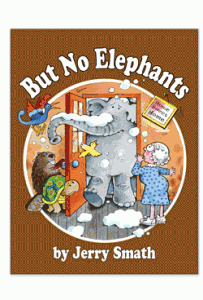 So we met in the foyer as Jerry and his wife were going out for dinner. “Jerry Smath!” I said. “I love your work. We read But No Elephants about a thousand times in our house.” Jerry told me he had a picture book coming out with Abrams, and I of course told him I had a book sitting on the shelf there. “Send it to me,” he said. “I’ll see if I like it.” So I did, assuming, as I always do, that nothing would come of it. About a week later, he called me and told me that he loved it and he’d done sketches for the whole book, and did I want to see them. Well, once I picked myself up from the floor, I answered in the affirmative. Mel and I drove up to Croton, where he lives, and sat in his living room and looked at them, and I could not believe what he’d done. He’d had so many clever ideas for spicing up the text. He was the perfect illustrator for this book, and I happened to meet him in the foyer of an inn in Massachusetts.
So we met in the foyer as Jerry and his wife were going out for dinner. “Jerry Smath!” I said. “I love your work. We read But No Elephants about a thousand times in our house.” Jerry told me he had a picture book coming out with Abrams, and I of course told him I had a book sitting on the shelf there. “Send it to me,” he said. “I’ll see if I like it.” So I did, assuming, as I always do, that nothing would come of it. About a week later, he called me and told me that he loved it and he’d done sketches for the whole book, and did I want to see them. Well, once I picked myself up from the floor, I answered in the affirmative. Mel and I drove up to Croton, where he lives, and sat in his living room and looked at them, and I could not believe what he’d done. He’d had so many clever ideas for spicing up the text. He was the perfect illustrator for this book, and I happened to meet him in the foyer of an inn in Massachusetts.
All those fabulous details in the art—did you and Jerry come up with that stuff together? Fleanut Butter and Jelly! The Chicago Grubs!
All, all Jerry’s. And the way the text goes around in a circle on that one page? Jerry! And that fabulous grub doll? Jerry!
One of my favorite things is hearing about other writers’ work process. I ask everyone this. How do you work? Where? How much thinking do you do away from the desk? Do you work at a set time every day? Does it depend on the project? I eat gummy bears to help me think—anything like that for you? Tea or coffee? Music or silence?
Man, I wish I could say I was one of those writers who works from 8AM to 2PM every day without fail. But in fact, my writing time gets more chaotic over the years. I used to write anything that was important to me with pen and paper first, but over the years I’ve transitioned to all computer. But I just read Annie Proulx saying you HAVE to write with a pen, so I’m considering taking her advice. No music, ever. It screws up my rhythm.
Because I started freelancing when my daughter was born, I just set up my desk in the living room and learned to work with whatever distractions exploded around me. I’m not one of those people who needs a room with a door. Though it would be nice. I remember once when as an editor, I needed to call James Howe about something, and I got his wife. “He’s working now,” she said. “He’ll call you this evening.” Wowww,” I thought. “I need a doorkeeper!”
And then there’s the constant battle to shut out the siren song of Free Cell…
[People with six homeschooled kids plus a career don’t know about Free Cell, I’m sure.]
(Ha! You are talking to a woman who has 14 games of Lexulous going simultaneously.)
You have collaborated on many projects with your husband, Mel Friedman. What’s it like when you work together? Are you sitting there together, typing? Or do you brainstorm together and then one of you goes and writes?
For years after I stopped editing kids’ magazines and started writing books, I would get stuck on plots and ask Mel to help me, and he’d come up with amazing ideas. Finally it occurred to me that we should work together “officially.” We divide up pretty neatly: he’s the idea guy and I’m the get-it-written guy. He has the most amazing mind—kind of runs in a Douglas Adams groove. So we hammer out ideas together, mostly meaning that he comes up with a million and I cull the ones I think I can actually write. We have a sort of tradition of going out for breakfast or lunch at diners and working. Or we work in the car on the way up to the country. Then I write, he comments, and I rewrite.
Now: Your new beginning reader, Porky and Bess, which is possibly my favorite title ever. And a completely charming book. Same questions—what sparked it? Will we be seeing more of Porky and Bess?
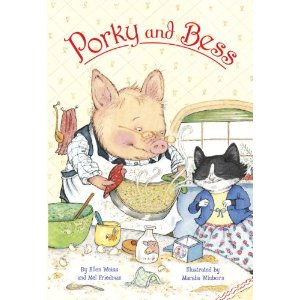 Thank you for liking the name! I kind of love it too, she said immodestly. In fact, for several years, all there WAS was the name. We tried this story and that story, and nothing was working right, until finally I woke up one morning, and boing, there it was: early reader, Frog and Toad-style. After that it was easy. More Porky and Bess? Your mouth to God’s ears, as my grandmother used to say. It’s looking good. Fingers crossed. We have lots of ideas—in fact, there’s a whole chapter already written that we couldn’t fit into the first book, about Porky’s lonely grandfather clock, which needs only a grandmother clock to make it happy. You heard it here first.
Thank you for liking the name! I kind of love it too, she said immodestly. In fact, for several years, all there WAS was the name. We tried this story and that story, and nothing was working right, until finally I woke up one morning, and boing, there it was: early reader, Frog and Toad-style. After that it was easy. More Porky and Bess? Your mouth to God’s ears, as my grandmother used to say. It’s looking good. Fingers crossed. We have lots of ideas—in fact, there’s a whole chapter already written that we couldn’t fit into the first book, about Porky’s lonely grandfather clock, which needs only a grandmother clock to make it happy. You heard it here first.Do you have a favorite genre or reading level to write? I think you must have written every type of children’s book there is to write—picture books, beginning readers, novels, nonfiction, everything!
The only genre I haven’t written is YA, which kind of scares me, which is why I should probably do one someday. Actually, Mel and I are working on an idea now which started out as a middle-grade novel, but our agent feels it should be a YA book, so that day may be coming soon. Eeek!
One of my favorite Ellen Weiss books is Odd Jobs. Can you tell us a bit about that one, how you came up with the idea, how you tracked down the people with interesting jobs, etc?
That begs a question about your reading life (since writers tend to be readers, first and always). What do you like to read? Who are your favorite authors? (Or favorite books if that’s easier.)
Love Philip Pullman. Love Shel Silverstein. Love Daniel Pinkwater. Reading now, and loving, Octavian Nothing. Love first, most, and always, Winnie-ther-Pooh.
For grownups, Don DeLillo, Jane Austen, Michael Chabon, and Garcia Marquez immediately come to mind.
Any favorite publishing stories? You must have a million.
Oh no! Ouch!!
Ellen, thanks so much for visiting us here in the Bonny Glen. I could keep asking questions all day, but Rilla is clamoring for another read-aloud of Lola. (She has informed me that she is the little sister shrew sitting on the stack of books at the dinner table is. Bet you didn’t know that.)
• Jen Robinson’s Books Page review of The Taming of Lola
• Lola at Seven Impossible Things Before Breakfast
• Ellen Weiss’s website
• Jerry Smath’s website
More books by Ellen Weiss:
Ellen’s four delightful Twins books are soon to be reissued as board books by Simon & Schuster. Huck is very glad to hear this news. He enjoys eating books about twins.
Bonny Glen was down all morning due to server problems. Happy to say all is well again and I have something very fun on deck for tomorrow (barring more server hijinks). See you then!
…is how many we visited (2) or telephoned (1) this morning on my quest for the May issue of The Believer SO I CAN FINISH THE NICK HORNBY COLUMN.
#1 only had the March/April (no Hornby).
#2, fresh out.
#3, again with the March/April issue! Aren’t we practically in June already, in magazine-publishing terms?
Signed,
Impatient
Comments are off
I’m realizing I view Henry James with a degree of suspicion: I have a nagging sense that he looks down on all his characters, despises them a little. He seems to work so hard to make them nuanced and complex and human, but always there’s this faint whiff of condescension—as if, once he’s made them brought them to life, he finds them somewhat repulsive because of the very flaws he has worked so hard to convey.
I don’t know, maybe I’m misreading him. This is all coming out of nowhere, really. Last night I picked up Portrait of a Lady because I thought I was in the mood for some James. The mood had passed by this morning, but last night it was compelling. I started (re)reading Portrait sometime last year; before that I hadn’t read it since college. Last year I got as far as Madame Merle’s entrance and then I thought, ugh, depressing, I don’t want to relive the rest of this. The book made its way back to the shelf.
Last night I tried to find where I’d left off, but the book opened to Chapter 12, when Lord Warburton proposes to Isabel. Reading that scene cold, without the buildup of the previous 90 pages, I was blown away by the—well, by the nuance and complexity and raw human-ness of these characters. James is so patient; if he were a painter he’d be a pointillist, dot dot dot with the brush. Except he wouldn’t be a painter at all: too imprecise: he’d be a sculptor, a Pygmalion chipping out a living, breathing person tap by tap by tap. Only—instead of falling in love with his creation, I think James is a little repulsed by her sweat and spittle.
But that sense of his repulsion comes later, after I put the book down, never while I’m reading. Which makes me wonder if I’m completely making it up. I’ve read next to no lit-crit on James; I have no idea whether this is something the scholars all take as a given, or a brand of foolishness they’d laugh down. I just know he makes me uneasy; somehow I don’t trust him.
But gracious, he can go deep into the mind of a character. This passage is breathtaking:
Isabel herself was upset, but she had not been affected as she would have imagined. What she felt was not a great responsibility, a great difficulty of choice; it appeared to her there had been no choice in the question. She couldn’t marry Lord Warburton; the idea failed to support any enlightened prejudice in favour of the free exploration of life that she had hitherto entertained or was now capable of entertaining. She must write this to him, she must convince him, and that duty was comparatively simple. But what disturbed her, in the sense that it struck her with wonderment, was this very fact that it cost her so little to refuse a magnificent “chance.” With whatever qualifications one would, Lord Warburton had offered her a great opportunity; the situation might have discomforts, might contain oppressive, might contain narrowing elements, might prove really but a stupefying anodyne; but she did her sex no injustice in believing that nineteen women out of twenty would have accommodated themselves to it without a pang. Why then upon her also should it not irresistibly impose itself? Who was she, what was she, that she should hold herself superior? What view of life, what design upon fate, what conception of happiness, had she that pretended to be larger than these large, these fabulous occasions? If she wouldn’t do such a thing as that then she must do great things, she must do something greater. Poor Isabel found ground to remind herself from time to time that she must not be too proud, and nothing could be more sincere than her prayer to be delivered from such a danger: the isolation and loneliness of pride had for her mind the horror of a desert place. If it had been pride that interfered with her accepting Lord Warburton such a betise was singularly misplaced; and she was so conscious of liking him that she ventured to assure herself it was the very softness, and the fine intelligence, of sympathy. She liked him too much to marry him, that was the truth; something assured her there was a fallacy somewhere in the glowing logic of the proposition—as he saw it—even though she mightn’t put her very finest finger-point on it; and to inflict upon a man who offered so much a wife with a tendency to criticise would be a peculiarly discreditable act.
How perfectly he nails Isabel’s discomfort with her own undeniable sense that she is somehow special, meant for extraordinary things. And how viciously honest she is with herself—which makes it all the more painful, later, to see her ignore that earnest inner voice, stubbornly making tragic choices. At least, that’s how I remember it, but it’s been almost twenty years since I read the tragic parts. Oh, Isabel.
It wasn’t until today, when I went to copy out the passage, that I was able to put my finger on the uneasiness I felt as I read this chapter last night—my distrust of James. I am probably being terribly unfair to him. And yet…”she did her sex no injustice in believing that nineteen women out of twenty would have accommodated themselves to it without a pang.” Yow. That’s a nasty little jab, there, Mr. James. When Austen does that sort of thing, you sense her vast affection for humanity—I’m thinking of Anne’s line in Persuasion: “All the privilege I claim for my own sex (it is not a very enviable one, you need not covet it)….” There’s wryness there, but no disdain. Austen is deeply fond of her characters, and, one senses, the real people who inspire them. James seems quietly scornful of the whole lot of them. It’s like he’s an Iron Chef creating culinary masterpieces with a main ingredient he finds distasteful.
Via Omnivoracious:
Nick Hornby resurrects his “Stuff I’ve Been Reading” column in The Believer (subscription only): “I have decided to vent my spleen by embarking on a series of books that, I hope, will be of no interest whatsoever to the readership of this magazine.” [via The Second Pass]
Looks like The Believer has just earned itself another subscriber. I. Am. So. Excited. To hear this news. I got hooked (via a Mental Multivitamin post) on Hornby’s column about his eclectic reading life not long before the column went away, breaking my heart into forlorn little pieces. Fortunately, the entire run of “Stuff I’ve Been Reading” was collected into three separate books—The Polysyllabic Spree, Housekeeping vs. The Dirt, and Shakespeare Wrote for Money—each of which was given to me as a sweet surprise by my indulgent and tolerant husband, the Scotch tape who holds together all the pieces of my heart. (It belongs to him, after all. I suppose he has incentive for keeping it in one piece.)
And now it’s back? O joy! O rapture! (I always think I am quoting Pudd’nhead Wilson when I say that, but now it occurs to me it may actually be the Scarecrow from The Wizard of Oz. Or else a Gilbert & Sullivan song. Huh.)
Anyway. This is excellent news for those of us who enjoy reading about other people’s reading lives. Which I emphatically do.
Especially when they chronicle them with as much wit and insight as Hornby does. Confer:
How does he love me? Let me count the books.
The trouble is, I fancy too much.
The “Books I Bought This Month” lists are one of the things I love about these essays. Hornby begins each column with side-by-side listings of books bought and books read, on the premise that the books you want to read, intend to read, go so far as to purchase in order to read, say as much or possibly even more about you as what books you actually do read. He explored this idea in a thoughtful passage I would like to quote, but five minutes ago Scott left for the library and The Polysyllabic Spree is, alas, mine no more. I mean, it was never mine at all, but I loved it well during its tenancy under this roof. Laid it tenderly upon a tasseled velvet pillow when home duties forced me to turn away from its enchanting pages for a while.
Who, me, prone to hyperbole? I haven’t the faintest, slightest, teeniest crumb of a morsel of an idea what you’re talking about.
Comments are off